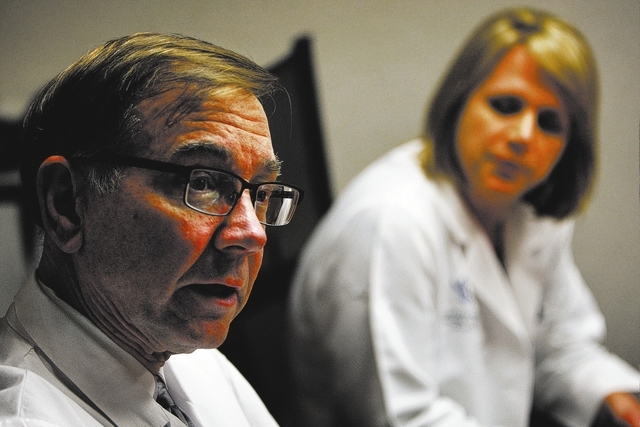Future of cancer treatments
The news spurred hundreds of phone calls and emails to Comprehensive Cancer Centers of Nevada from across the country: Two Stage 4 cancer patients at the Las Vegas center, after participating in the first human trial of an antibody drug with the unwieldy code name of MPDL 3280A, were now cancer-free.
Rosemary Rathbun, 78, had been so far gone with throat cancer that doctors told her to enroll in hospice. Lorrine Rodgers, 56, had been told there were no other treatments for her spreading breast cancer.
That their cancer disappeared, the women said in January, was a miracle.
The miracle, said Dr. Fadi Braiteh, the oncologist for both women, resulted from immunotherapy. Each woman’s immune system was unleashed — thanks to a new drug delivered intravenously — to attack her cancer cells.
Cancer cells’ ability to evade the immune system has frustrated researchers for decades. Why, researchers wondered, did white blood cells in the lab always kill cancer cells but not in the body? In recent years, scientists learned the answer: Cancerous tumors wrap themselves in an invisible molecular shield or camouflage. Researchers also learned some drugs could break through the shield, which could allow the immune system to attack cancerous cells.
Now cancer researchers and clinicians, excited about immunotherapy’s results, say they have a new weapon to fight cancer, which kills about 1,500 Americans a day, according to the American Cancer Society.
In December, as Rathbun and Rodgers underwent treatment they say had no discernible side effects, the editors of Science, the flagship journal of the American Association for the Advancement of Science, were so impressed by encouraging results from dozens of continuing, worldwide clinical trials that they selected cancer immunology as the “Breakthrough of the Year.”
Many questions remain. Why do some people not respond to immunotherapy? Why do some who initially respond see their cancer progress and die from it?
During a round-table discussion, researcher/clinicians from Comprehensive Cancer Centers addressed both cancer immunology and what the future of cancer treatment might hold. The panel included Drs. Heather Allen, Fadi Braiteh, Oscar B. Goodman Jr., Regan Holdridge, Edwin Kingsley, H. Keshava Prasad, Wolfram Samlowski, Matthew Schwartz and Nicholas Vogelzang.
Vogelzang, a world-renowned researcher/clinician whose work has helped lead to therapies for five cancers, led the recent discussion at Comprehensive Cancer Centers’ South Eastern Avenue location in Las Vegas. During the discussion, oncologists answered questions from the Las Vegas Review-Journal.
Vogelzang: I remember one of the first patients I treated with an immune stimulator was a young woman with cancer in her liver. It (the ocular melanoma) started in her eye and 20 years later she is free of the disease even though her liver was full of cancer. It gave me a great appreciation for the potential of the immune system once it can be appropriately harnessed. Dr. Braiteh, do you want to share your experience?
Braiteh: If we empower the immune system … treatment … can work across different diseases: kidney cancers, melanoma, bladder, breast. Now suddenly all of them can be in the same bucket if we understand the mechanism of how these cancers can be shielding themselves from the immune system. In the news you will follow about the two particular shields that cancer can hide behind — the PD-L1 and PD1 — and how drugs are being developed against those two targets. We’ve had experience with PD-L1 and PD1, particularly PD-L1. Comprehensive Cancer Centers was one of six centers nationwide to be “first-in-human testing,” which means the drug has never been provided to human beings before. … We have … patients, at least two or three with bladder cancer who have … also … been rendered cancer-free.
Kingsley: Just a few months ago, the (Food and Drug Administration) approved a new oral medication for … a difficult lymphoma to treat, and we are seeing very dramatic responses … with a different toxicity profile than the standard kinds of chemotherapy … and much better tolerated. … We are all expecting that drug to be approved for other types of leukemias and lymphomas in the next six months. … This field is very hot right now.
Prasad: With regard to … chronic myeloid leukemia, until the ’90s we expected a life span of three to four years. Now routinely they live 10 to 20 years and some are probably cured.
Kingsley: Another drug was just approved by the FDA for chronic lymphocytic leukemia. … I just treated my first patient (with it) last month. His white blood count was over 3,000 — that’s not good — and just two weeks after he got his dose, his white blood count was 1,800. … Never have I seen anything so dramatic. It’s almost miraculous. … What’s very exciting is with these new drugs coming down the pipeline, patients don’t have to leave the state to get newer, better treatments.”
Allen: The thing that has revolutionized the treatment of breast cancer is what we call targeted therapy. … Certain drugs (laboratory-produced antibodies carefully engineered to attach to specific defects in cancer cells) are very active against certain tumors that express certain molecular targets. That’s where the whole interest is in breast cancer. There are some other revolutionary ideas where you take that targeted agent (the antibody) and you tie it to a cytotoxic (chemotherapy) agent in such a way that the targeted agent (antibody) takes it to the cell, doesn’t release that cytotoxic agent until it gets into the cell. How they were ever able to accomplish that, I will never in my lifetime know, but that is a huge achievement.
Vogelzang: Let’s talk about that a little bit. That’s got principles that advance not only into lymphoma and breast cancer but also to prostate cancer. It’s basically a molecule antibody, like a magnet, that attaches to the surface of a cell. At the nonbusiness end of the magnet is a linker that links to a chemical that is potent. The cell absorbs the magnet and the potent chemo, and not only does it work for breast cancer, we have the (antibody) Brentuximab for Hodgkin’s.
Kingsley: Brentuximab is going to be revolutionary. In fact, there’s a study right now where they are looking at Brentuximab and changing the whole way we have been treating Hodgkin’s lymphoma for the last 20 years, and we think this study is going to change things worldwide.
Vogelzang: So, the principle is that the magnet (antibody) that hits the cell is a really powerful magnet, but each cell has to be identified as having the right magnetism, the right connection, and then the delivery molecule is individualized somewhat for Hodgkin’s disease, or for breast cancer … prostate cancer. … Dr. Samlowski, do you want to talk about the melanoma story a little bit?
Samlowski: Melanoma, after 30 years of futility, has become one of the poster children for cancer treatment advances … The one avenue is identifying the five or six genetic changes in pigment cells that lead to malignancies and those lead to uncontrolled growth. And if you can block that, you can develop oral medicines that prevent the cancers from growing off and shrink it dramatically. … Those have been successful, but tend to be short-lived because cancers learn to outwit those. The other avenue that has been phenomenally successful is … reactivating the immune system, so now there’s a whole series of monoclonal antibodies that either activate white blood cells or prevent them from being shut off by the cancer. We are going to spend the next decade seeing that form of treatment. The advantage of those is although they don’t produce as quick of a response, they often produce very long-lasting responses. And at this point in melanoma, at least 20 percent of patients with advanced melanoma have long-term survivorship and it might look like we are heading to 50 percent.
Vogelzang: And we do begin to use the word cure. … Two of the older approaches … to treat cancer … mainly radiation and hormones … are also becoming better all the time. Dr. Schwartz, do you want to take it away on radiation?
Schwartz: Sure. Going along with this theme of treatment being more targeted, that’s where the advances are really going in radiation therapy as well. … Instead of blasting away at an area, we are using pinpoint — think laser beam — radiation treatments. … For tumors like lung cancer … the patients are breathing so the tumors are moving. … The (radiation) machine is actually … tracking the tumor in real time … moving as the patients are breathing. It has submillimeter precision. So, for people with lung cancer who can’t get surgery because they are too sick, they can get three to five treatments of (radiation) with cure rates in the range of 70 to 80 percent, which are almost exactly the same as surgery. We are able to cure some patients of lung cancer without having to undergo surgery.
Goodman: Over the years, it was observed that there were phenomenal responses to (hormonal) treatment in prostate cancer. About 90 to 95 percent of these men would have these miraculous responses where they would be near death, but would get up and recover. … In time, unfortunately … (in) the vast majority of … men … the cancer becomes resistant to hormonal therapy. … The cancer goes to great pains to go around the blockades we put up with hormonal therapies. … In the last three or four years, we have two new approved treatments that are directed at this concept. … We are turning cancer, which was once a death sentence, into a chronic disease. … Prostate cancer was the first solid malignancy that was shown in immunotherapy to have a survival benefit. … We’ve had a couple patients … have near complete responses to treatment. … In the future, we will be moving towards being able to cure cancer. I feel like that’s coming in all or most of our lifetimes.
Review-Journal: A lot of writers will talk about the slowness of the attack (on cancer), how we are still at “slash, poison and burn.” Talk … about that.
Braiteh: Medical oncology is one of the most stressful for practitioners to keep up with. Because on average, an FDA-approved drug or indication of a new drug is once every three weeks. That really beats any other specialty, so the perception of being slow is not there. We are really moving fast, but it’s never fast enough.
Review-Journal: You have to deal with people who know (little) … about science.
Holdridge: The concept of being on a clinical trial is so foreign to a lot of people and scary. I hear it from people all the time, “I don’t want to be a guinea pig.” You really have to rewind for patients and explain to them about the overall benefit of participating in a clinical trial. You have to explain, “You are the patient that is watched the most closely.”
Samlowski: The thing … you have to realize about clinical trials are some of us monitor these drugs for a long time and see effectiveness years before they are released to the general public. We already know they are working and we want to get our hands on them as soon as we possibly can to help our patients. … We are sort of cheating, it’s like insider trading.
Review-Journal: Do we have difficulty getting people for these trials?
Kingsley: They come here from a long distance, so it’s the other way around.
Review-Journal: It seems like in the last five years things have reached a critical mass … things are really churning.
Vogelzang: They are. It’s just popping constantly.
Contact reporter Paul Harasim at pharasim@reviewjournal.com or 702-387-2908.























